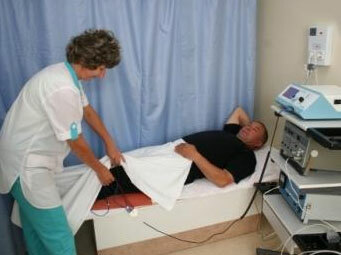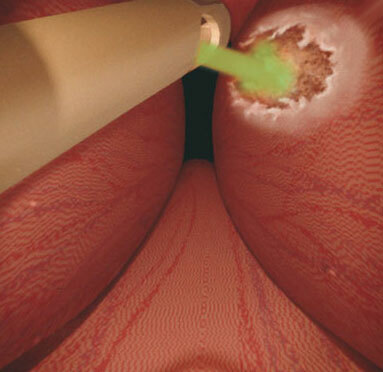That is, it can be said that surgery to remove the prostate gland is not carried out: it is only about removing the part of the prostate that pushes the urethra.
Prostate adenoma is removed by two basic operations:
- transurethral;
- transvesical.
The necessary type of operation is chosen by the attending physician. What is the difference between these two types of operations?
Transurethral resection( endoscopic)
The TOUR of the prostate is a highly technological operation.
The patient is placed on his back with his legs bent in the knees and diluted in the sides. The doctor inserts a resectoscope( special medical instrument) through the urethra into the bladder. All actions are under visual control.
Resectoscope removes( as it were, shaves) the inflamed layers of prostate tissue and conducts moxibustion( coagulation) of bleeding vessels.
The collected tissue is sent to the doctor-morphologist for advice. At the end of the operation, a urinary catheter is inserted into the bladder.
There is no external incision, therefore, the total time spent in the hospital is reduced.
Transvesical resection( overflow)
This kind of operation is performed in an open mode: the skin between the pubis and the navel is cut. Then cut the subcutaneous fat layer of the cellulose, muscle and the anterior wall of the bladder. In the resulting hole, the doctor enters his finger and conducts removal of the prostate adenoma( removes the overgrown nodes).Through the urethra, a catheter( or cystostomy tube) is inserted into the bladder, which is discharged through the postoperative wound to the outside.
After this operation the patient is in hospital for a longer time.
Preparation for operation on the prostate gland
 The time allotted to stay in the urological center takes 5-20 days.
The time allotted to stay in the urological center takes 5-20 days.
Before the operation, it is necessary to perform the following actions:
- to pass a blood test( for hepatitis, HIV, syphilis);
- pass the urinalysis;
- pass ECG( electrocardiography);
- to do a chest x-ray.
In addition:
- should undergo ultrasound( ultrasound) of the urinary system;
- to conduct uroflowmetry( measurement of the rate of urination);
- determine the level of PSA( prostate-specific antigen) of the blood.
The patient is examined by an anesthesiologist and therapist to determine the type of anesthesia( general or spinal anesthesia).
On the eve of the operation, a cleansing enema is placed, the surface of the skin on the pubis shaves.
From midnight( from 0 o'clock) a ban on food and drink is introduced.
In the morning, antibiotic therapy is provided( intravenous and intramuscular antibiotics).
Postoperative period
Usually, after the operation on prostate adenoma, a permanent irrigation system( furatsilinom or other special solution) of the bladder is established. This system is installed most often for two or three days.
After a couple of hours( in the absence of vomiting and nausea) it is allowed to drink simple portions( still water) in small portions. Eating is usually resumed the next day.
Antibiotic therapy can be continued after about 10-30 days( depending on complications and the nature of concomitant diseases).After removing the catheter, the color of urine may be light or with an admixture of blood.
In addition, sometimes it is possible:
- strong and frequent urge to urinate;
- and burning in the urethra.
However, after 7-8 weeks, these postoperative symptoms usually go away.
Prostate cancer( operation)
In the treatment of prostate cancer in the early stages, there are three main treatment options:
- hormone therapy;
- radiotherapy( irradiation or implantation of radioactive grain);
- surgical operation.
If the cancerous opruhol is entirely within the gland, then its complete removal( prostatectomy) is possible.
It should be borne in mind that surgery on the prostate does not affect the erectile function: the erection remains at the same level.
The prostate adenoma after the operation is completely cured and has no negative consequences for either the surrounding organs or the whole organism.
Reviews for the operation of prostate adenoma
Vladimir:
Operated in 2009.I wanted to undergo a procedure of laser vaoprizatsii or TURP, but I had too much bladder volume. I was offered treatment by the method of endovascular embolization. No local anesthesia is required for the procedure. After the operation, I felt much better: if I used to go to the toilet before seven times a night, now the intervals between urination increased to three hours. The urine stream became much more powerful, the volume of urination reached 250 ml( although before it reached barely 50 ml).
It's amazing how such an effective technique still remains in the shadows?
Video: TUR adenoma of the prostate
 Any operation to remove adenoma of the prostate is carried out with one goal - to remove excess tissue from the prostate gland that interferes with the normal process of urination.
Any operation to remove adenoma of the prostate is carried out with one goal - to remove excess tissue from the prostate gland that interferes with the normal process of urination.



